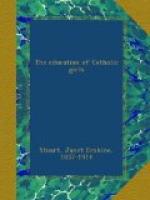During the great development which has taken place in the study of history within the last century, and especially within the last fifty years, the mass of materials has grown so enormous and the list of authors of eminence so imposing that one might almost despair of adapting the subject in any way to a child’s world if it were not for this central point of view, in which the Incarnation and the Church are the controlling facts dominating all others and giving them their due place and proportion. On this commanding point of observation the child and the historian may stand side by side, each seeing truth according to their capacity, and if the child should grow into a historian it would be with an unbroken development—there would not be anything to unlearn. The method of “concentric” teaching against which there is so much to be said when applied to national history or to other branches of teaching is entirely appropriate here, because no wider vision of the world can be attained than from the point whence the Church views it, in her warfare to make the kingdoms of the world become the kingdom of God and His Christ that He may reign for ever and ever. The Church beholds the rational not the sensible horizon of history, and standing at her point of view, the great ones and the little ones of the earth, historians and children, can look at the same heavens, one with the scientific instruments of his observatory, the other with the naked eye of a child’s faith and understanding.
But the teaching of history as it has been carried on for some years, would have to travel a long way to arrive at this central point of view. As an educational subject a great deal has been done to destroy its value, by what was intended to give it assistance and stimulus. The history syllabus and requirements for University Local and other examinations have produced specially adapted text-books, in which facts and summaries have been arranged in order with wonderful care and forethought, to “meet all requirements”; but the kind intention with which every possible need has been foreseen between the covers of one text-book has defeated its own purpose, the living thing is no longer there—its skeleton remains, and after handling the dry bones and putting them in order and giving an account of them to the examining body, the children escape with relief to something more real, to the people of fiction who, however impossible to believe in, are at least flesh and blood, and have some points of contact with their own lives. “Of course as we go up for examinations here,” wrote a child from a new school, “we only learn the summaries and genealogies of history and other subjects.” A sidelight on the fruit of such a plan is often cast in the appreciations of its pupils. “Did you like history?” “No I hated it, I can’t bear names and dates.” “What did you think of so and so?” “He wasn’t in my period.” So history has become names and dates, genealogies and summaries, hard pebbles




